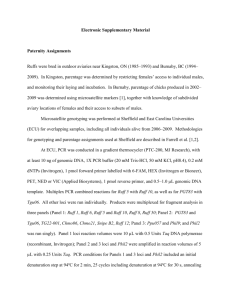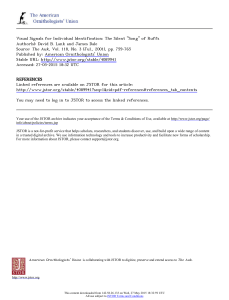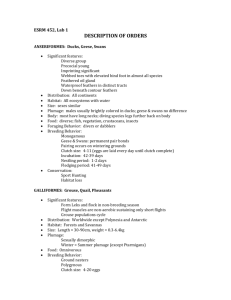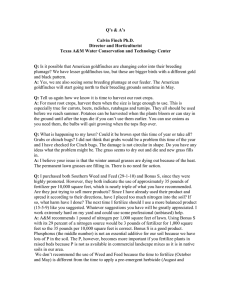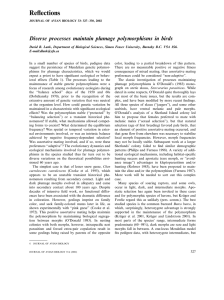759 Visual Signals for Individual Identification: The Silent ‘‘Song’’ of Ruffs
advertisement
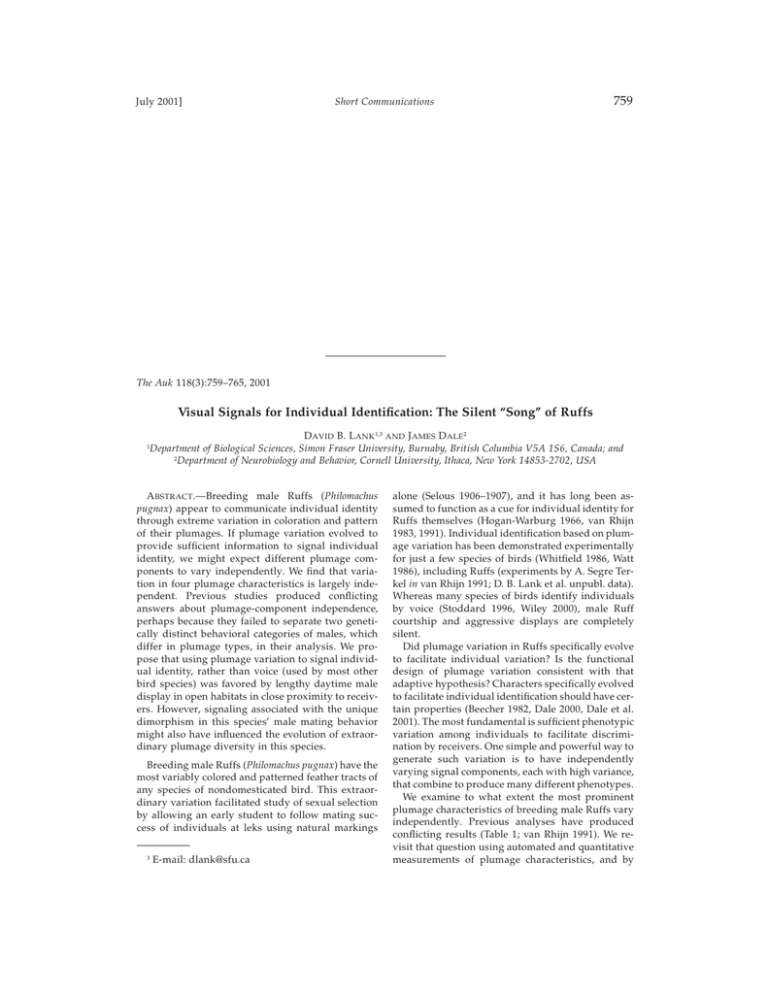
July 2001] Short Communications 759 The Auk 118(3):759–765, 2001 Visual Signals for Individual Identification: The Silent ‘‘Song’’ of Ruffs DAVID B. LANK1,3 AND JAMES DALE2 Department of Biological Sciences, Simon Fraser University, Burnaby, British Columbia V5A 1S6, Canada; and 2 Department of Neurobiology and Behavior, Cornell University, Ithaca, New York 14853-2702, USA 1 ABSTRACT.—Breeding male Ruffs (Philomachus pugnax) appear to communicate individual identity through extreme variation in coloration and pattern of their plumages. If plumage variation evolved to provide sufficient information to signal individual identity, we might expect different plumage components to vary independently. We find that variation in four plumage characteristics is largely independent. Previous studies produced conflicting answers about plumage-component independence, perhaps because they failed to separate two genetically distinct behavioral categories of males, which differ in plumage types, in their analysis. We propose that using plumage variation to signal individual identity, rather than voice (used by most other bird species) was favored by lengthy daytime male display in open habitats in close proximity to receivers. However, signaling associated with the unique dimorphism in this species’ male mating behavior might also have influenced the evolution of extraordinary plumage diversity in this species. Breeding male Ruffs (Philomachus pugnax) have the most variably colored and patterned feather tracts of any species of nondomesticated bird. This extraordinary variation facilitated study of sexual selection by allowing an early student to follow mating success of individuals at leks using natural markings 3 E-mail: dlank@sfu.ca alone (Selous 1906–1907), and it has long been assumed to function as a cue for individual identity for Ruffs themselves (Hogan-Warburg 1966, van Rhijn 1983, 1991). Individual identification based on plumage variation has been demonstrated experimentally for just a few species of birds (Whitfield 1986, Watt 1986), including Ruffs (experiments by A. Segre Terkel in van Rhijn 1991; D. B. Lank et al. unpubl. data). Whereas many species of birds identify individuals by voice (Stoddard 1996, Wiley 2000), male Ruff courtship and aggressive displays are completely silent. Did plumage variation in Ruffs specifically evolve to facilitate individual variation? Is the functional design of plumage variation consistent with that adaptive hypothesis? Characters specifically evolved to facilitate individual identification should have certain properties (Beecher 1982, Dale 2000, Dale et al. 2001). The most fundamental is sufficient phenotypic variation among individuals to facilitate discrimination by receivers. One simple and powerful way to generate such variation is to have independently varying signal components, each with high variance, that combine to produce many different phenotypes. We examine to what extent the most prominent plumage characteristics of breeding male Ruffs vary independently. Previous analyses have produced conflicting results (Table 1; van Rhijn 1991). We revisit that question using automated and quantitative measurements of plumage characteristics, and by Significance varies depending on color categorization scheme. a Ruff pattern and wattle color Ruff or head tuft color 3 wattle color Ruff color 3 head tuft patterning Ruff color 3 ruff patterning Captured on breeding grounds Museum specimens Observed on leks Collected on migration Described at leks Caught at leks Collected on migration Caught on breeding grounds Shot, on migration and breeding Caught at leks Caught on breeding grounds Caught at leks Caught on breeding grounds Caught at leks Caught on breeding grounds Caught on breeding grounds 39 164 214 80 100 98 110 77 508 98 81 98 78 98 62 52 Nonrandom Nonrandom Nonrandom Random Random/nona Nonrandom Nonrandom Random Random Random Random Nonrandom Nonrandom Random Random Random Andersen 1948 Andersen 1948 Hogan-Warburg 1966 Geethe 1953 J. Shepard, in Drenekhahn 1975 van Rhijn 1991 Drenckhahn 1975 This study Lindemann 1951 van Rhijn 1991 This study van Rhijn 1991 This study van Rhijn 1991 This study This study [Auk, Vol. 118 Ruff color 3 head tuft color Relationship n Source of sample Relationship examined Tests of relationships between plumage characteristics of breeding male Ruffs. considering whether two behavioral types of male ruffs, which differ in predominant plumage colors, should be analyzed separately. Background. Ruff males molt into breeding plumage prior to and during spring migration. Following a prealternate body molt on the wintering grounds (Pearson 1981), adult males grow fluffy ornamental feathers of a neck ‘‘ruff’’ and ‘‘head tufts’’ during a supplemental molt (Jukema and Piersma 2000) that continues during migration. The ruff, head tuft, and body feathers vary in color and pattern in ways comparable to the pelages of domestic cats (Felis domesticus), ranging from white through rusts to blacks (Cramp and Simmons 1983, Hayman et al. 1986), and being solid colored, flecked, barred, and patchy in both regular and irregular arrangements (Glutz von Blotzheim et al. 1975). Males lose their display feathers immediately after the breeding season, typically prior to migration, and complete their prebasic molt after migration (Pearson 1981). Within days of arrival on the breeding grounds, adult males aggregate at leks located at open sites, often near preferred nesting areas (Andersen 1948, Lank and Smith 1987, Höglund et al. 1998). Most males establish ;0.3 m diameter mating courts, located only 1–2 m apart, which they aggressively defend against most other breeding males. However, males with substantial amounts of white, and little black, in their ruff and head tufts do not attempt to establish mating courts (Hogan-Warburg 1966, van Rhijn 1973). Instead, these ‘‘satellites,’’ which comprise 15–20% of males, share display courts with the territorial ‘‘independent’’ males (Hogan-Warburg 1966, Hugie and Lank 1997, Widemo 1998). The behavioral difference between territorial and satellite morphs is determined by alternative alleles of a balanced genetic polymorphism (Lank et al. 1995, 1999; Widemo 1998), and plumage differences also appear to have a genetic basis (Lank and Smith unpubl. data). Lekking males advertise their presence at long distances by flashing their wings or hovering over courts when they detect flying Ruffs (Hogan-Warburg 1966, Widemo and Owens 1995). All other intra- and intersexual display occurs at close quarters on the ground (Hogan-Warburg 1966, van Rhijn 1973, 1991). Females visit multiple courts and multiple leks for about a week prior to egg-laying, mate with one or several males (Lank et al. 1995, in press), and provide all parental care. Methods. This analysis is based on photographs of the breeding plumages of 82 male Ruffs caught near Oulu, Finland, in the springs of 1984–1990. The photos were digitized and analyzed with Adobe Photoshopt version 3.0 (Dale 2000). Photographs were taken under ambient outdoor light, and most included a color standard used to ensure colors were consistent among images. We reduced variation between photographs by standardizing the contrast in Reference Short Communications TABLE 1. 760 July 2001] Short Communications each image using the ‘‘Auto Levels’’ option under the ‘‘Image: Adjust’’ menu in Photoshopt. We quantified four characteristics of Ruff breeding coloration. (1) Ruff shade: to simplify the analysis of ruff coloration, we used Photoshop’st histogram function to reduce color to a grayscale value ranging from black (5 0) to white (5 255). Under that scale, brown is measured as dark grey, whereas shades of rust and buff are lighter grey. We scored only the predominant shade in the ruff when more than one was present. We divided scores by 2.55 to produce a scale ranging from 0 (5black) to 100 (5white). (2) Head tuft shade: if several shades were present, we scored the predominant shade at the end of the head tufts. (3) Wattle hue: breeding male Ruffs lose feathers on their faces and develop papillae-like facial wattles around their eyes and the base of the bill. Wattles range in hue from deep red to yellow. We used Photoshop’st ‘‘Color Picker’’ to quantify that trait. Because all wattle hue values fell between pure red (0) and pure yellow (60), we treated hue as a linear variable, with lower values indicating more red. For convenience, we refer to wattle hue as a ‘‘plumage’’ characteristic. (4) Ruff pattern: pattern was scored as a categorical variable. We recognized (a) solid, for uniform ruffs, (b) flecked, being sprinkled with small spots, (c) barred, including lines and stripes, and (d) splotchy, including all other irregular secondary ruff markings. Repeated measures of the same males using separate photographs demonstrated that our measures were highly repeatable (ruff shade: r2 5 0.97, n 5 7; head tuft shade: r2 5 0.97, n 5 5; wattle hue: r2 5 0.72, n 5 3, ruff pattern: r2 5 1.0, n 5 6). Variance in scores for color standards were much lower than variance in actual plumage scores: variance in standards as a percentage of variance in plumage scores were 2.2–13.4% for ruff shade (five standards, n 5 14 photos), 2.4–4.3% for head tuft shade (five standards, n 5 13 photos), and 12.4% for wattle hue (one standard, n 5 11 photos). Not all characteristics were available for all birds. Males were identified as either independents or satellites on the basis their behavior, where known, or from their plumage type (Hogan-Warburg 1966), which includes more information than the characters included in this paper. Results. Both plumage brightness characters had complex multimodal distributions, with high frequencies of predominantly black tracts and a spread across other shades (Fig. 1A, B). The modality of wattle colors was difficult to resolve with that sample (Fig. 1C), but may be uni-, bi,- or even trimodal, with peaks at red, orange, and yellow (c.f. van Rhijn 1991). Patterns were distributed evenly (Fig. 1D), but this could change with the system of categorization. Plumage brightness was not significantly correlated between ruff and head tuft (Table 2, Fig. 2), indicating that those two characters assort largely independently. Five of the six correlations between 761 characters are not significant (Table 2). Head tuft color covaried with ruff pattern, however, with darker head tufts over represented among birds with flecking and barring. In contrast to earlier studies, we analyzed satellites separately from independents, because satellite plumages cover a narrower range of colors, lacking black tracts. The results are similar when the whole sample or only independents are examined; our sample was insufficient to test satellites only. The unimodal distribution of pattern types among the satellites (solid ruffs only, Fig. 1D) is an artifact of a small sample that does not reflect the full spectrum seen in nature. Finally, the independent males scored with both light ruff and light tufts (upper right corner of Fig. 2) also had patches of black or brown that are not included in this analysis. Discussion. Wiley (2000) recently suggested that sexually selected aspects of bird song might be aptly termed auditory ‘‘plumes.’’ The display plumages of Ruffs, conversely, function in some ways as a silent ‘‘song.’’ The most prominent plumages characteristics of breeding male Ruff demonstrated high variance, non-normal frequency distributions, and varied largely independently of each other. Why did previous studies of covariation produce conflicting results (Table 1; van Rhijn 1991)? Statistical power does not appear to explain the differences. In addition to potential methodological differences in scoring plumage characteristics, a more subtle effect may be differential representation of satellites in samples. Because satellites have a smaller range of colors than independents (Hogan-Warburg 1966; Figs. 1A, B), samples with higher proportions of satellites are more likely to produce significant correlations. Because satellites and independents have different movement patterns, proportions differ among samples collected on migration versus breeding grounds, birds observed at leks versus more widely on the breeding grounds, and even for birds captured versus counted at leks. The nonindependent patterns we document agree with details of previous studies. Both the significant relationship between head tuft color and patterning of the ruff (Table 2) and a paucity of birds with brown or rusty colored ruffs but white head tufts (Fig. 2) occur in the most comparable previous tabulations (Hogan-Warburg 1966, van Rhijn 1991). The independent variation of Ruff plumage characters is consistent with the hypothesis that variation evolved specifically to facilitate individual recognition (Beecher 1982, Dale 2000, Dale et al. 2001). A popular alternative functional explanation for plumage variation in other species is that it indicates aspects of a male’s condition, or quality (Rohwer 1975, Andersson 1994, Hill and Montgomerie 1994). Signals evolved to identify individuals should not be condition-dependent, and not correlate with fitness (Dale et al. 2001). Evidence against condition-dependence is that despite uniform rearing conditions, 762 Short Communications [Auk, Vol. 118 FIG. 1. Frequency distributions of four characters measured in the breeding coloration of male Ruffs (n 5 82). Separate distributions are shown for residents (black bars) and satellites (grey bars). (A) ruff shade, (B) tuft shade, (C) wattle hue, (D) ruff pattern. See methods for scaling and categorization. captive-reared populations display the full range of color variation observed in the wild (D. Lank and C. M. Smith unpubl. data). Male Ruffs do have age and condition-dependent characters that do correlate with mating success, including the length and density of display plumes, extent of facial wattles, and leg and bill color, as well as behavioral displays and social interactions (Shepard 1975, Hill 1991, Widemo 1997). In sharp contrast, however, all authors conclude that plumage coloration is not correlated with mating success (Selous 1906–1907, Hogan-Warburg 1966, Shepard 1975, Hill 1991, van Rhijn 1991, D. Lank and C. M. Smith unpubl. data). Although no formal studies of neighbor–stranger recognition using vocal signals of shorebirds have been published, behavioral observations and song descriptions from numerous species suggest that does occur (e.g. Baker 1982, Miller 1984). Ruddy Turnstones use both variable plumage and calls to signal individual identity (Ferns 1978; Whitfield 1986, 1988, and pers. comm.). Ruffs now use plum- age variation, rather than vocal variation, to signal their identity. Why might this change have occured? The most important features of Ruff breeding biology that may have favored the evolution of visual signals, and made vocal signals of lesser value, are lengthy daytime display in open habitats in close proximity to multiple receivers. Resident males remain on leks throughout the long arctic days (Lank and Smith 1987). Plumage variation allows those males to continuously signal their identity to lekmates and visiting females without incurring the additional costs of vocal signals. Ruff mating courts are only approximately 1–1.5 m apart, and residents and satellites often cooccupy courts, at times in physical contact (Hogan-Warburg 1966, van Rhijn 1991, Hugie and Lank 1997), making it the most densely packed of all lekking birds. At such close quarters, long-distance transmission through visually obscured environments, a major advantage of vocal signals, does not apply. July 2001] 763 Short Communications TABLE 2. Correlations between plumage and wattle characters in male Ruffs. Results of analysis are given for the entire sample of males (upper right matrix) and for the sample with satellites excluded (lower left matrix). Spearman rank correlations were used to evaluate relationship between continuous quantitative characters, and Kruskal-Wallis tests were used to evaluate relationship between pattern (a categorical character) and the quantitative traits. Boldface indicates P , 0.05. Ruff Ruff — Head tuft Wattle Pattern Rho n P Rho n P H n P 5 20.16 5 65 5 .19 5 0.26 5 51 5 0.07 5 1.9 5 69 5 0.59 Head Tuft Wattle (Satellites included) Rho 5 0.14 Rho 5 0.16 n 5 77 n 5 62 P 5 0.21 P 5 0.22 Rho 5 0.12 — n 5 62 P 5 0.33 Rho 5 0.16 n 5 51 — P 5 0.27 H 5 12.2 H 5 4.8 n 5 66 n 5 52 P 5 .007 P 5 0.19 (Satellites excluded) Silence on the lek is not entirely restricted to Ruffs. Several other species with ground-displaying males use little vocalization once females are on mating courts. Buff-breasted Sandpipers (Tryngites subruficollis), a close relative of the Ruff, in which males defend moderately sized, clumped-lek territories, have nearly silent close-range courtship (Lanctot and Laredo 1994). Despite their notorious long-distance calls, courting peafowl (Pavo cristatus) do not vocalize in that situation. The unique male behavioral dimorphism in that species (Hogan-Warburg 1966) may also have contributed to the evolution of extreme plumage differentiation among male Ruffs. Plumage differences might have initially evolved to signal a male’s prob- Pattern H n P H n P H n P 5 5.5 5 81 5 0.14 5 17.6 5 78 5 .0005 5 5.2 5 63 5 0.16 — able behaviour as a satellite or independent. Given the complex relationship between the two types of males (van Rhijn 1973, 1991; Hugie and Lank 1997, Widemo 1998), selection favors a reliable indicator of male type. The most honest signal would covary genetically with alleles for male behavioural morph (Lank et al. 1995, 1999), and a plumage marker might have evolved to serve that purpose. Once males of different colors became acceptable mating partners, directional selection on female preferences for plumage color per se would have been relaxed, allowing spread of additional mutations, if signaling individual identity were favored (Johnstone 1997). Acknowledgments. We thank Connie Smith for participating in the field work, and P. Whitfield, F. Widemo, and D. Kroodsma for comments on the manuscript. This research was funded by grants to D.B.L. from the National Geographic Society, the Fulbright Foundation, the National Science Foundation and the NSERC. J. D. was supported by the Cornell University Graduate School. LITERATURE CITED FIG. 2. Scattergram of ruff shade vs. head tuft shade. Independents are closed circles and satellites are open circles. ANDERSEN, F. S. 1948. Contributions to the biology of the Ruff (Philomachus pugnax (L.)) II. Dansk Ornitologisk Forening Tidsskrift 38:25–148. ANDERSSON, M. 1994. Sexual Selection. Princeton University Press, Princeton, New Jersey. BAKER, M. C. 1982. Individuality of vocalization in Dunlin: A possible acoustic basis for recognition of parent by offspring. Auk 99:771–774. BEECHER, M. D. 1982. Signature systems and kin recognition. American Zoologist 22:477–490. CRAMP, S., AND K. E. L. SIMMONS , EDS. 1983. The Birds of the Western Palearctic, vol. 3. Oxford University Press, Oxford. 764 Short Communications DALE, J. 2000. Ornamental plumage does not signal male quality in Red-billed Queleas. Proceedings of the Royal Society of London, Series B 267: 2143–3149. DALE, J., D. B. LANK, AND H. K. REEVE. 2001. Signaling individuality vs. quality: A model and case studies with Red-billed Queleas and Ruff sandpipers. American Naturalist 158:75–86. DRENCKHAHN, D. 1975. Das Prachtkleid männlicher Kampfläufer (Philomachus pugnax). Corax 5:102– 113. FERNS, P. N. 1978. Individual differences in the head and neck plumage of Ruddy Turnstones (Arenaria interpres) during the breeding season. Auk 95:753–758. GOETHE , F. 1953. Färbungstypen männlicher Kampfläufer aus den Pripjet-Sümpfen. Vogelring 22: 43–47. GLUTZ VON BLOTZHEIM, U. N., K. M. BAUER, AND E. BEZZEL. 1975. Handbuch der Vögel Mitteleuropas, vol. 6. Academische Verlagsgesellschaft, Wiesbaden, Germany. HAYMAN, P., J. MARCHANT, AND T. PRATER. 1986. Shorebirds: An Identification Guide to the Waders of the World. Houghton Mifflin Co., Boston. HILL, G. E., AND R. MONTGOMERIE. 1994. Plumage color signals nutritional condition in the House Finch. Proceedings of the Royal Society of London, Series B 258:47–52. HILL, W. L. 1991. Correlates of male mating success in the Ruff Philomachus pugnax, a lekking shorebird. Behavioral Ecology and Sociobiology 29: 367–372. HOGAN-WARBURG, A. L. 1966. Social behaviour of the Ruff, Philomachus pugnax (L.). Ardea 54:109– 229. HÖGLUND, J., F. WIDEMO, W. J. S UTHERLAND, AND H. NORDENFORS. 1998. Ruffs, Philomachus pugnax, and distribution models: Can leks be regarded as patches? Oikos 82:370–376. HUGIE, D. M., AND D. B. LANK. 1997. The resident’s dilemma: A female-choice model for the evolution of alternative male reproductive strategies in lekking male Ruffs (Philomachus pugnax). Behavioral Ecology 8:218–225. JOHNSTONE, R. A. 1997. Recognition and the evolution of distinctive signatures: when does it pay to reveal identity? Proceedings of the Royal Society of London, Series B 264:1547–1553. JUKEMA, J., AND T. PIERSMA. 2000. Contour feather moult of Ruffs Philomachus pugnax during northward migration, with notes on homology of nuptial plumages in scolopacid waders. Ibis 142: 289–296. LANCTOT, R. B., AND C. D. LAREDO. 1994. Buff-breasted Sandpiper (Tryngites subruficollis). In The Birds of North America, no. 90 (A. Poole and F. Gill, Eds.) Academy of Natural Sciences, Phila- [Auk, Vol. 118 delphia, and American Ornithologists’ Union, Washington, D.C. LANK, D. B., M. C OUPE, AND K. E. WYNNE -EDWARDS. 1999. Testosterone-induced male traits in female Ruffs (Philomachus pugnax): Autosomal inheritance and gender differentiation. Proceedings of the Royal Society of London, Series B 266:2323– 2330. LANK, D. B., AND C. M. SMITH. 1987. Conditional lekking in Ruff (Philomachus pugnax). Behavioral Ecology and Sociobiology 20:137–145. LANK, D. B., C. M. SMITH, O. HANOTTE, T. A. BURKE, AND F. COOKE . 1995. Genetic polymorphism for alternative mating behaviour in lekking male Ruff, Philomachus pugnax. Nature 378:59–62. LANK, D. B., C. M. S MITH, O. HANOTTE, A. O HTONEN, S. BAILEY, AND T. BURKE. 2001. High frequency of polyandry in a lek mating system. Behavioral Ecology 12:in press. LINDEMANN, W. 1951. Über die Balzerscheinungen und die Fortflanzungsbiologie beim Kampfläufer (Philomachus pugnax L.). Zeitscrift für Tierpsychologie 8:210–224. MILLER, E. H. 1984. Communication in breeding shorebirds. Pages 241–257 in Shorebirds: Breeding Behavior and Populations (J. Burger and B. L. Olla, Eds.). Plenum Press, New York. PEARSON , D. L. 1981. The wintering and moult of Ruffs Philomachus pugnax in the Kenyan Rift Valley. Ibis 123:158–182. ROHWER, S. A. 1975. The social significance of avian winter plumage variability. Evolution 29:593– 610. SELOUS, E. 1906–1907. Observations tending to throw light on the question of sexual selection in birds, including a day-to-day diary on the breeding habits of the Ruff (Machetes pugnax). Zoologist 10: 201–219, 285–294, 419–428; 11:60–65, 161–182, 367–381. SHEPARD, J. M. 1975. Factors influencing female choice in the lek mating systems of the Ruff. Living Bird 14:87–111. STODDARD, P. 1996. Vocal recognition of neighbors by territorial passerines. Pages 356–374 in Acoustic Communication in Birds (D. E. Kroodsma and E. H. Miller, Eds.). Cornell University Press, Ithaca, New York. VAN RHIJN, J. G. 1973. Behavioural dimorphism in male Ruffs, Philomachus pugnax (L.). Behaviour 47:153–229. VAN RHIJN, J. G. 1983. On the maintenance and origin of alternative strategies in the Ruff Philomachus pugnax. Ibis 125:482–498. VAN RHIJN, J. G. 1991. The Ruff: Individuality in a Gregarious Wading Bird. Academic Press, London. WATT, D. J. 1986. A comparative study of status signaling in sparrows (genus Zonotrichia). Animal Behaviour 34:1–15. July 2001] Short Communications WHITFIELD, D. P. 1986. Plumage variability and territoriality in breeding turnstone Arenaria interpres: Status signalling or individual recognition? Animal Behaviour 34:1471–1482. WHITFIELD, D. P. 1988. The social significance of plumage variability in wintering turnstone, Arenaria interpres. Animal Behaviour 36:408–415. WIDEMO, F. 1997. The social implication of traditional use of lek sites in the Ruff, Philomachus pugnax. Behavioral Ecology 8:211–217. 765 WIDEMO, F. 1998. Alternative reproductive strategies in the Ruff, Philomachus pugnax: A mixed ESS? Animal Behaviour 56:329–336. WIDEMO, F., AND I. P. F. OWENS . 1995. Lek size, male mating skew and the evolution of lekking. Nature 373:148–151. WILEY, R. H. 2000. A new sense of the complexities of bird song. Auk 117:861–868. Received 4 August 2000, accepted 2 February 2001. Associate Editor: D. Kroodsma
